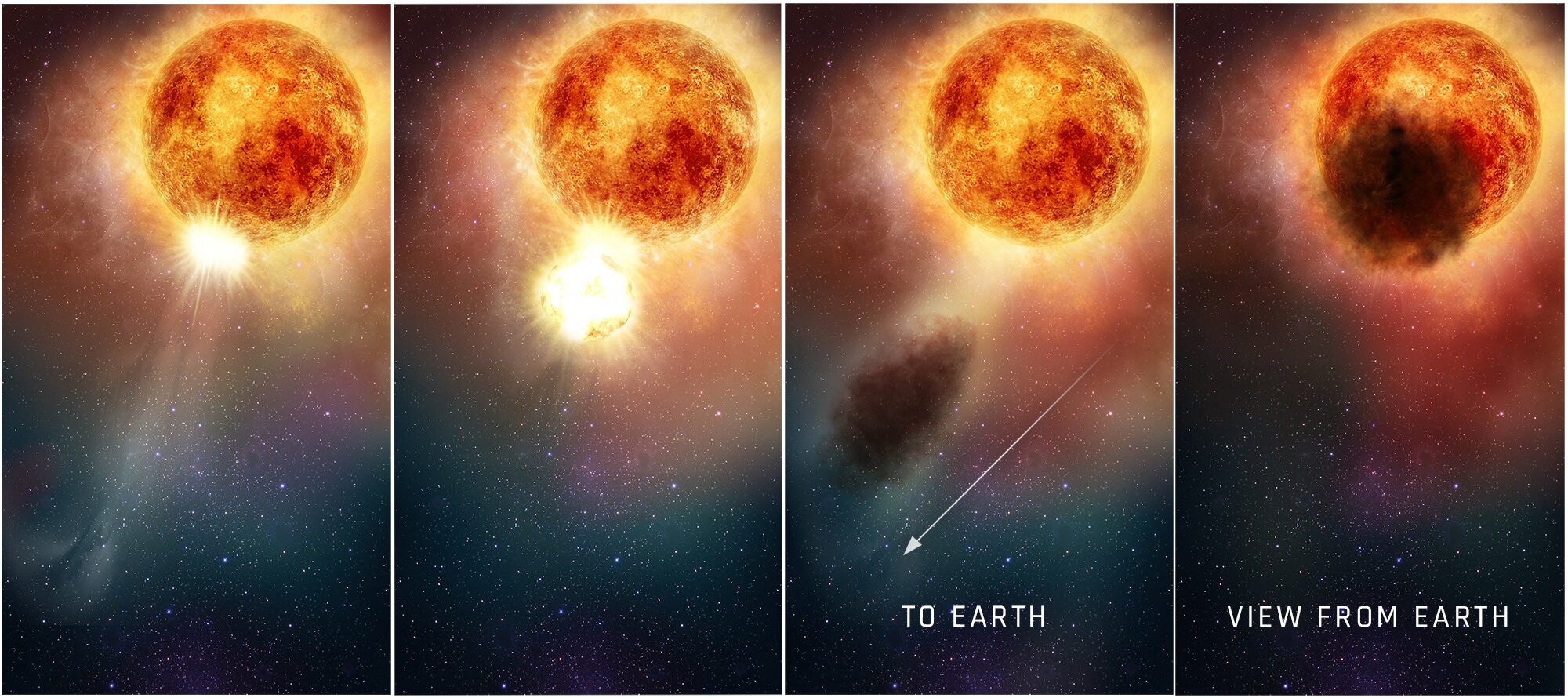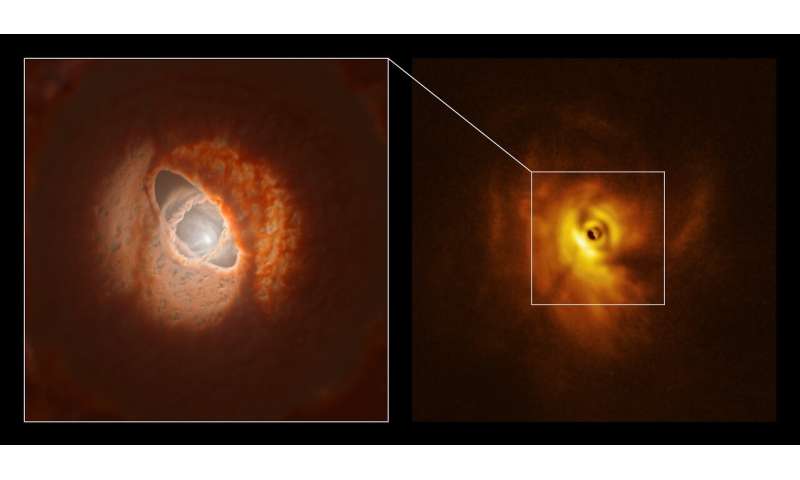|
|
Post by jandl100 on Aug 14, 2020 5:23:46 GMT
The weird brightness fluctuations of the bright star Betelgeuse ... Still not going supernova.  Thanks to Hubble space telesope it's back to the ejected dust cloud theory. "With Hubble, we had previously observed hot convection cells on the surface of Betelgeuse and in the fall of 2019 we discovered a large amount of dense hot gas moving outwards through Betelgeuse's extended atmosphere. We think this gas cooled down millions of miles outside the star to form the dust that blocked the southern part of the star imaged in January and February," phys.org/news/2020-08-hubble-betelgeuse-mysterious-dimming-due.html?utm_source=nwletter&utm_medium=email&utm_campaign=daily-nwletter |
|
|
|
Post by MartinT on Aug 14, 2020 7:37:31 GMT
The weird brightness fluctuations of the bright star Betelgeuse ... Still not going supernova. Before you get too excited at the prospect of it going supernova, remind me how far away it is again?  |
|
|
|
Post by MartinT on Aug 14, 2020 7:40:32 GMT
Magnetars
|
|
|
|
Post by jandl100 on Aug 14, 2020 7:47:58 GMT
The weird brightness fluctuations of the bright star Betelgeuse ... Still not going supernova. Before you get too excited at the prospect of it going supernova, remind me how far away it is again?  745 light years? Quite safe. Probably.  |
|
|
|
Post by jandl100 on Aug 14, 2020 18:38:11 GMT
|
|
|
|
Post by jandl100 on Aug 18, 2020 9:13:31 GMT
Maybe it's time to forget the Big Bang. There's observational evidence that it might have been a Big Bounce instead. physicsworld.com/a/microwave-anomalies-strengthen-the-case-for-loop-quantum-cosmology-say-physicists/The Cosmic Microwave Background [CMB] shows certain anomolies that have defied explanation. But a theory of fundamental physics called Loop Quantum Gravity [LQG] can, it seems, explain them quite accurately. The application of LQG to the broader Universe is known as loop quantum cosmology (LQC). And one of the tenets of LQG is that space is quantised at the Planck length, which is a rather tiny 10 -35m. That would be the irreducible size of anything. 'In standard Big Bang cosmology, were we to run the history of the universe backwards so that it collapses rather than expands, the universe would contract into an unknowable singularity. However, in LQC, the collapsing universe would stop collapsing at the Planck length, and then rebound. This suggests that if LQC is correct, there was no Big Bang singularity, but a Big Bounce resulting from the collapse of a previous universe.' Mind blown! |
|
|
|
Post by MartinT on Aug 18, 2020 10:25:37 GMT
Strictly speaking, mind blown from one possible start to this universe, to another possible start! |
|
|
|
Post by jandl100 on Aug 18, 2020 10:41:00 GMT
The idea of a cyclic, bouncing universe has been around for ages, millenia probably! - but afaik this is the first time there has been observational evidence for it that uniquely distinguishes it from other cosmological theories (e.g. Big Bang, Steady State) and fundamental physical theories (e.g. string theory) such that a rigourously defined Bouncing Universe theory successfully accounts for a number of observational anomalies that the other theories can't.
I'm sure this has all sorts of implications for the universe we live in, it will be interesting to see how this pans out.
|
|
|
|
Post by MartinT on Aug 18, 2020 12:27:46 GMT
I like the idea of the Planck length defining the smallest size of anything, including the universe!
|
|
|
|
Post by jandl100 on Aug 19, 2020 6:41:56 GMT
The weird brightness fluctuations of the bright star Betelgeuse ... Still not going supernova. Before you get too excited at the prospect of it going supernova, remind me how far away it is again?  Interesting article here theorising that a fairly nearby supernova caused a mass extinction on Earth 359 million years ago. Decent background info also provided ... "A supernova ... delivers a one-two punch, the researchers said. The explosion immediately bathes Earth with damaging UV, X-rays and gamma rays. Later, the blast of supernova debris slams into the solar system, subjecting the planet to long-lived irradiation from cosmic rays accelerated by the supernova. The damage to Earth and its ozone layer can last for up to 100,000 years." Not good! A supernova has a "kill distance of 25 light-years", the theorised distance of the mass extinction supernova is 65 light years, extensive damage but we're still here! phys.org/news/2020-08-stars-mass-extinction-earth.html?utm_source=nwletter&utm_medium=email&utm_campaign=daily-nwletter |
|
|
|
Post by MartinT on Aug 19, 2020 6:49:03 GMT
Yikes! How many (old) stars within that distance?
|
|
|
|
Post by jandl100 on Aug 19, 2020 6:59:40 GMT
Yikes! How many (old) stars within that distance? Good old Wiki! " there are six near-Earth supernova candidates within 300 pc" (~1,000 ly) en.wikipedia.org/wiki/Near-Earth_supernova"On average, a supernova explosion occurs within 10 parsecs (33 light-years) of the Earth every 240 million years" Whoops! - that's a lot more than I would have thought. I'll start building my bunker as soon as the rain stops today! "Type Ia supernovae are thought to be potentially the most dangerous if they occur close enough to the Earth. Because Type Ia supernovae arise from dim, common white dwarf stars, it is likely that a supernova that could affect the Earth will occur unpredictably and take place in a star system that is not well studied." |
|
|
|
Post by jandl100 on Aug 25, 2020 3:14:56 GMT
Uh oh. The universe as implied by quantum mechanics has got even weirder. Try and get your ape brain around this new quantum paradox concerning the realness and consistency of "reality". source |
|
|
|
Post by MartinT on Aug 25, 2020 6:43:36 GMT
Ouch - I need a long think to absorb some of that.
Instead, I need to go to work!
|
|
|
|
Post by jandl100 on Aug 27, 2020 8:00:29 GMT
|
|
|
|
Post by jandl100 on Sept 4, 2020 6:05:59 GMT
It seems that not all planetary systems form in a single plane like our own solar system. New obeservations of a young stellar system with 3 stars and the usual debris disk which forms the ensuing planets show significant disruption of the disk which will lead to the creation of planets with heavily tilted orbits. So the fictional 2 sun system of Tatooine in Star Wars will likely have other planets at quite different orbital inclinations. These images are of the star system GW Orionis. This system, located just over 1300 light-years away in the constellation of Orion, has three stars and a deformed, broken-apart debris disc surrounding them.  "Our images reveal an extreme case where the disc is not flat at all, but is warped and has a misaligned ring that has broken away from the disc," says Stefan Kraus, a professor of astrophysics at the University of Exeter in the UK who led the research published today in the journal Science. The misaligned ring is located in the inner part of the disc, close to the three stars. The new research also reveals that this inner ring contains 30 Earth-masses of dust, which could be enough to form planets. "Any planets formed within the misaligned ring will orbit the star on highly oblique orbits and we predict that many planets on oblique, wide-separation orbits will be discovered in future planet imaging campaigns" phys.org/news/2020-09-planet-forming-disc-torn-central-stars.html?utm_source=nwletter&utm_medium=email&utm_campaign=daily-nwletter |
|
|
|
Post by jandl100 on Sept 8, 2020 11:18:00 GMT
|
|
|
|
Post by MartinT on Sept 8, 2020 11:51:29 GMT
If other alien lifeforms had a similar evolution and timing to ours, the likelihood of their radio transmissions reaching us would require them to be very close to us, otherwise we'd get nothing, which seems to be the case.
|
|
|
|
Post by jandl100 on Sept 8, 2020 12:07:27 GMT
Evolution timescales surely have random variances of millions of years, at the least, and at light speed that encompasses the whole of our galaxy.
So I think it is only a consideration of emitted radio power and our own instrument sensitivity.
... And also timing it right so the band of emitted radio radiation happens to pass over us at this time.
I think this timing aspect is as crucial as any other parameter.
|
|
|
|
Post by jandl100 on Sept 8, 2020 13:31:40 GMT
|
|